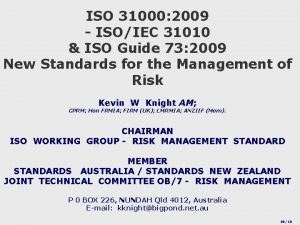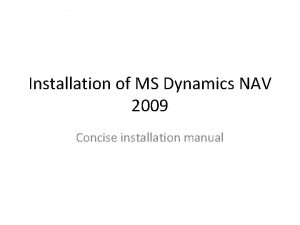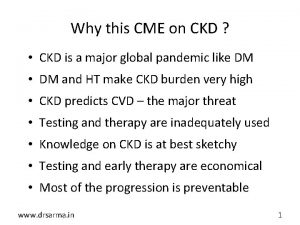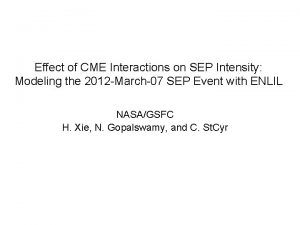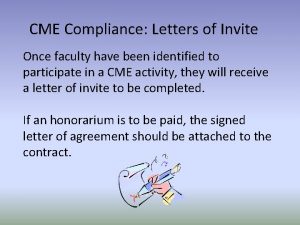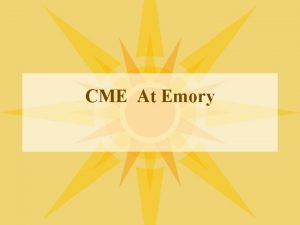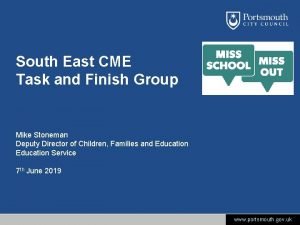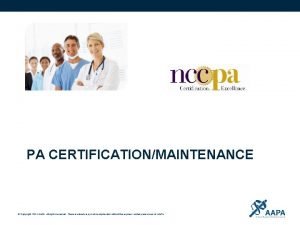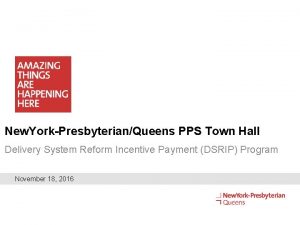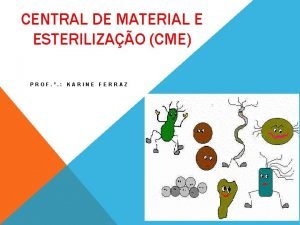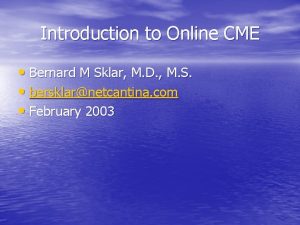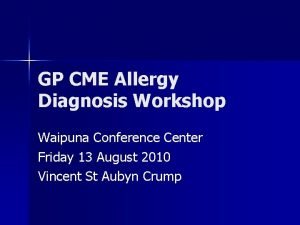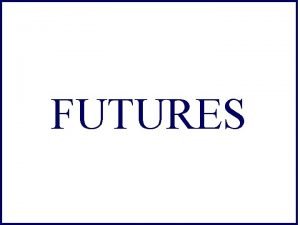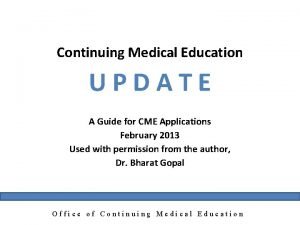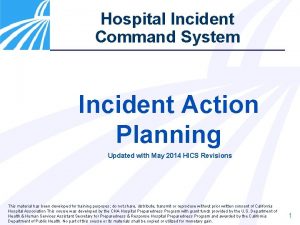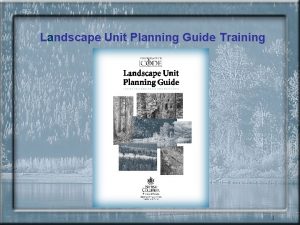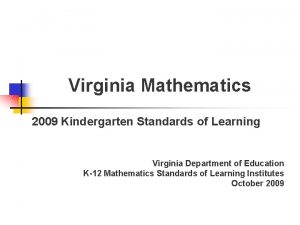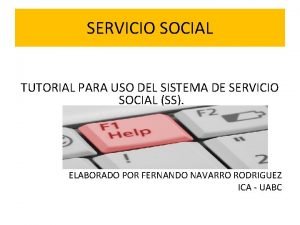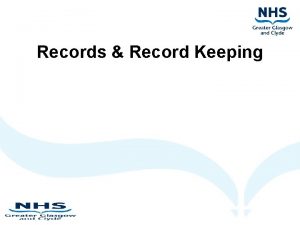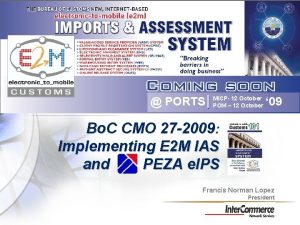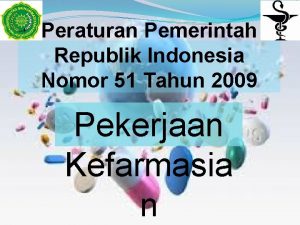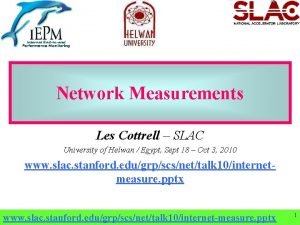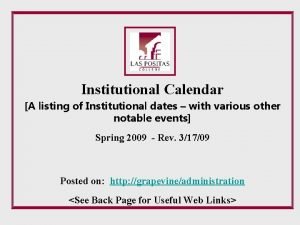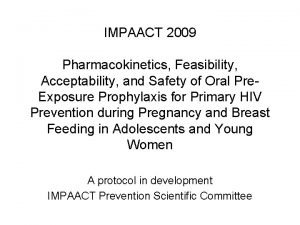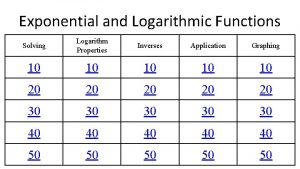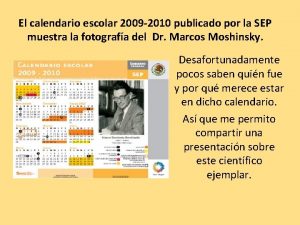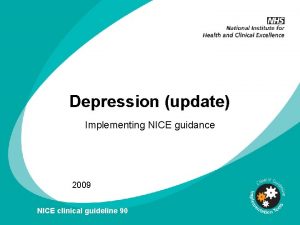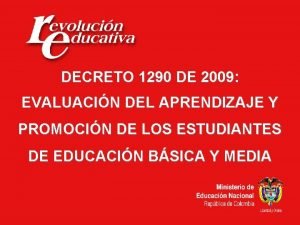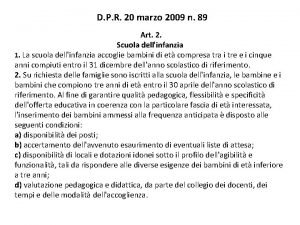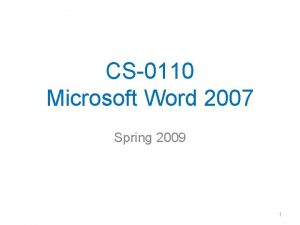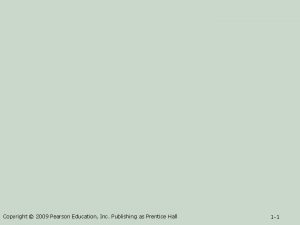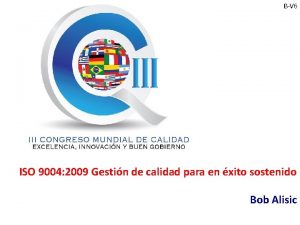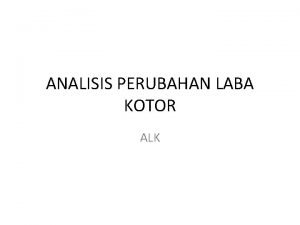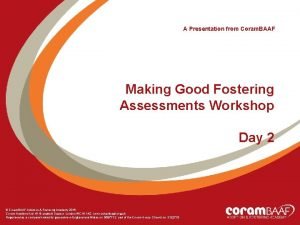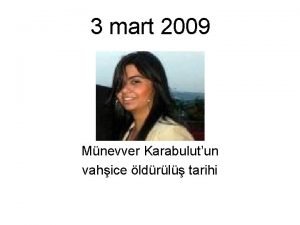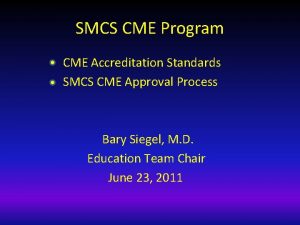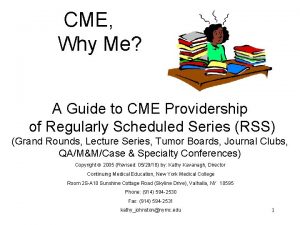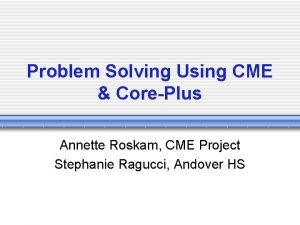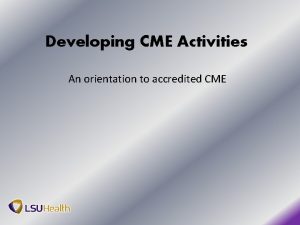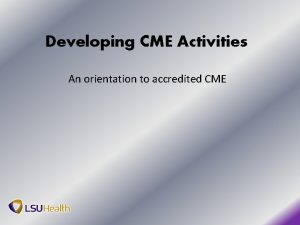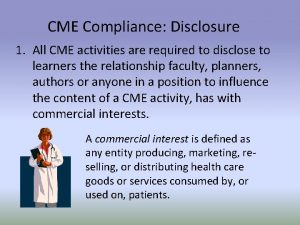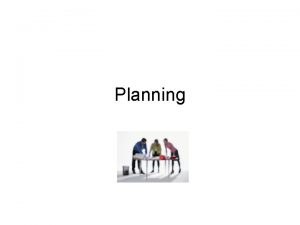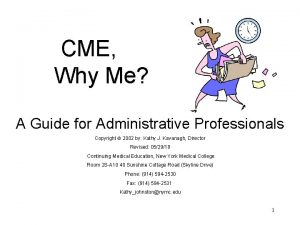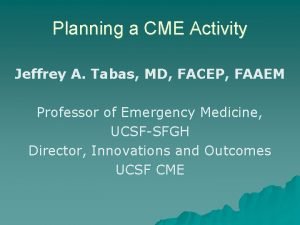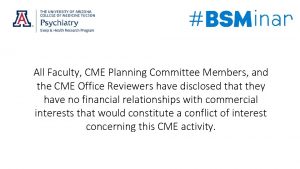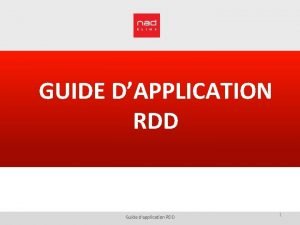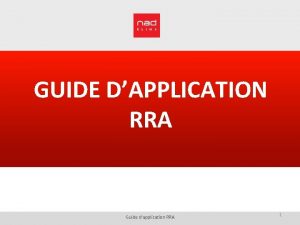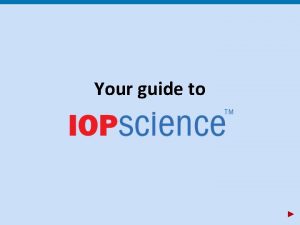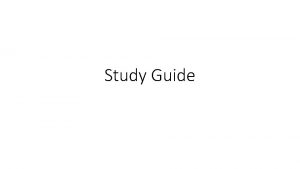A Guide to Planning CME in 2009 A





























































- Slides: 61

A Guide to Planning CME in 2009 A Tutorial for Course Chairs, Faculty, and Other Planners © Steve Passin & Associates, LLC, April 2009

Welcome CME Course Chairs, Faculty and Planners! You have been selected to plan, develop and execute this CME activity because of your established expertise in the content area of this activity. Your engagement with us explicitly implies that you have agreed to plan this CME activity in accordance with established principles on how adults learn and the regulatory requirements After reviewing this tutorial, please sign the attestation form. Thank you for your time, expertise, and commitment to improving the quality of patient care.

Modules in This Briefing 1. Adult Learning -Your Role 2. Standards for Commercial Support -The Requirements 3. The Planning Process -How you do it

MODULE 1 Adult Learning – Your Role

Adult Learning – Your Role The purpose of CME is to address gaps in knowledge, competence or performance of physician-learners in order to positively impact patient care. Transferring knowledge to your audience, while it can be the first step, is not sufficient to comply with ACCME continuing medical education requirements. CME is provided for the purpose of changing behavior, and the planning process embodies this principle.

CME is Designed to Achieve an Outcome Each activity must be designated for one or more of the 3 potential outcomes on the right Designation is based on the findings of the gap analysis you will perform Once designated, the activity must be measured to determine if the intended outcome was actually achieved Improve Competence Improve Performance Improve Patient Outcomes

Outcomes Designation Defined Outcome Definition based on ACCME Guidance Competence = Knowledge transferred, BUT with the strategy to apply to a practice situation. This is measured AT THE TIME OF THE ACTIVITY, and not retrospectively. It measures an increase in competence but not actual implementation. Performance = This is a retrospective evaluation of what the physician is doing differently in practice based on what was learned at the activity (self reported by the learner and normally investigated 90 days post -activity). Improvements in patient care based on learner self report, patient report or chart indicators. Patient Outcomes =

Designing Education for Results Adult learning literature tells us that lectures, by themselves, lead to few changes in physician performance primarily due to the passivity of learner interaction. To be effective education, planners must understand the current or potential scope of practice of the cohort of learners being targeted. The more actively engaged the participant is in the learning experience, the more transformational the experience.

Assessing Scope of Practice We ask your help in defining the current scope of practice of targeted learners What is the demographic in which the typical learner practices in terms of cultural diversity, urban vs suburban/rural environments, etc. ? Is the typical learner a diagnostician or procedureoriented or a mixture of both? Can you define Potential Scope of Practice for this target audience? What does the certifying specialty board or national specialty society say about the ideal scope of practice for this specialty?

Choosing Formats that Facilitate Change In order to facilitate change in your learners’ practices, choose from the following tactics to solicit their involvement: ü Thought-provoking question/answer that facilitates learners to examine the key issues in the presentation ü Case-based questions at the end of the presentation ü Story line case threaded throughout the presentation ü Audience Response System with practice-based questions ü Small group tasks with presentations ü Challenging cases presented by audience ü Demonstration with patient simulation ü Demonstration of skill based technique

Format Options and Rationale When considering which formats to choose, please consult Appendix C in the planning tool for guidance as shown to the right:

Summary of Key Points CME is designed to achieve a change in behavior If your activity is not for that purpose, consider revising it or not certifying it for AMA PRA credit The planning process starts with identifying learner gaps that become the basis for the content of the activity Gaps are specific and based on the comparison between current practice and best practice Changes in behavior are not achieved by one-off single activities Consider sequential education in which points are reinforced in multiple educational activities Understand the scope of practice of your targeted learners before developing content and be sure to match scope of practice to content Choose formats that engage the learner in the educational experience

MODULE 2 The Standards for Commercial Support Requirements for compliance

Overview In light of the current regulatory environment, compliance with the Standards for Commercial Support is critical. While the following rules may seem stringent, the intent is merely to uphold the ethics of the organization and comply with all of the required Standards.

Making Disclosure Be accurate and transparent about any relevant financial relationships in any amount you have had with manufacturers that support this activity or whose products are related to this activity or your presentation within the past year. Submit a signed disclosure form within 10 days of agreement of your role as planer or course director in order to identify and resolve any COI. If a conflict of interest is identified, agree to have content reviewed and edited based on an independent review from a qualified resource. Financial disclosures will be made transparent to learners in advance of the activity

Content that is Independent In your role as a planner, it is important that you agree to: Develop CME content based on the results of the gap analysis and other needs assessments. Ensure that CME content will not be influenced in any way by any manufacturer of a healthcare product or device. Present content that is fair balance, free of commercial bias, and based on scientific evidence. Base treatments recommendations on evidence in medical literature and/or current guidelines. Not accept supplementary funds or honorarium related to this activity other than the honorarium provided to you.

Consequences for Abuse of the Standards As an ACCME-accredited provider, it is necessary to comply with all rules in order to maintain our accreditation. Our primary focus is to develop educational activities that are consistent with the public interest. Should commercial bias be revealed through retrospective evaluation, the following will occur: 1 st time: internal review to establish credibility of claim and counsel 2 nd time: ineligibility to participate in CME planning or as an instructor

MODULE 3 The CME Planning Process

Overview As a planner, you are representing the scientific standards and integrity of the organization, and as such you play a critical role. We do understand that your time is limited and valuable; however, it must be understood that at the same time the rules for planning medical education have changed and it demands more of your time and diligence. We have established a comprehensive CME Planning Tool that will help you to appropriately plan and document CME activities.

The 4 Functions of CME Planning 1. Determine the educational gap of the learners targeted in this activity A gap is determined by comparing the targeted learners’ current practice relative to the topic against a related best practice If best practice is not defined by a guideline, as the planner you must define best practice based on your expert opinion and/or other content experts

The 4 Functions of CME Planning Step 1 (continued) Source of Gap Information and Gap Type Next, please record the source of both current and best practices together with the key point you extracted from that source If from a journal, provide all references to enable us to download that source document If from a guideline, indicate the name of the guideline, source of the guideline, and a URL if available For each Resulting Gap, click on one or more Gap Types, such as Knowledge (K), Competence (C), or Performance (P)

The 4 Functions of CME Planning Step 1 (continued) Therefore, your role is as follows: Access existing data that demonstrates current practice, summarize the data, and compare them to best practices, OR If studies of current practice don’t exist, work with us to convene a meeting with several physicians in the target audience to determine current practice in this topic area

The 4 Functions of CME Planning 2. Collaborate with us in designating the intended outcomes for the activity or elements of the activity Choices include: Improvement in competence, and/or Improvement in performance-in-practice, and/or Improvement in patient outcomes

The 4 Functions of CME Planning 3. Assist in the development of learning objectives that translate the practice gaps into CME content. Please remember that our staff are educators and they will collaborate with you to structure learning objectives that demonstrate the type of outcome established in the planning process. Objectives are specific, actionable and measurable, and are stated in terms of what changes the learner will make based upon the content in the activity Objectives should reflect the intended outcome type and are, therefore, linked to outcomes.

The 4 Functions of CME Planning 4. Collaborate with us on the design of the activity so that it: Changes behavior Engages the learner in the educational process Uses case studies both to reinforce learning and measure if the learner is able to apply knowledge to practice Reinforces learning goals by using ancillary tools as handouts or downloadable files to take back to the practice Assesses barriers that could derail your educational goals, and once identified designs strategies to resolve them in the CME content Includes opportunities to reflect on learning and the take-away actions of the learner

MODULE 4 Let's Walk Through Planning an Activity This sample activity is based on the general area of pain management. In this example you will be able to see how the steps of planning build one on the other, and see an actual example of how to move through the stages of planning CME.

Using the CME Planning Tool Start with completing basic information about the CME activity. Be specific about the target audience as your content will link back to the learners you indicate here. Instruction modules guide you through each step of planning a CME activity.

Gap Analysis • This is the Gap Analysis Worksheet that you will use to identify SPECIFIC learner gaps. • Remember, learner gaps are observed by contrasting a specific CURRENT PRACTICE of your targeted learners against a BEST PRACTICE as determined by national guidelines, experts, and other recognized medical or clinical authority. • Now, lets get specific!

The Gap Analysis Starting with the idea you identified, drill down to the specifics. Write down one current practice based on what you determined the learners in your target audience do. This needs to be a specific finding.

Gap Analysis Now, identify a best practice relating to the current practice you just observed. If you’re lucky, there is a valid and current guideline that can be accessed. Or, maybe a consensus statement that is useful. Perhaps one of the institutes of the NIH has identified a relevant best practice. Use the Internet to find your sources. If there isn’t a defined best practice, it is up to the expert planners to state the best practice they will adopt for this finding. In other words, what is the intended result you want for learners relating to this activity?

Gap Analysis Now, compare and contrast your specific Current Practice and Best Practices. The difference between the two is THE GAP. Repeat this process for each of the specific learner practices that comprise the total issue you identified. Indicate the ‘Gap Type’ in terms of a gap in knowledge (K), competence (C), and/or performance (P) Once completed, these series of gaps become the foundation of the content of your CME activity.

Sources of the Current and Best Practices Please let us know the specific sources you used to define Current and Best Practices. Again, be specific as we may be asked to use this activity to demonstrate compliance with ACCME Criteria for Accreditation.

Designating the type of outcome Based on the gaps that were revealed, you must determine whether your educational activity will improve one or more of these 3 possibilities: q Improved COMPETENCE q. Improved PERFORMANCE q. Improved PATIENT OUTCOMES Once you make this designation, the Outcomes Constructor at the end of the planning document will help you select an Outcomes Measurement tool that reflects the type of intended result.

Desirable Physician Attributes • Now, let’s take into account the 3 sets of competencies included in the planning document that represent a set of universal competency goals for all physicians. • As a planner, you must scan this listing of competencies and determine which ones relate to your activity. Usually there are several. • Once chosen, in the right column of the planning document place the number corresponding to the competency you intend to reference in the content of your activity and briefly explain the nature of your content that relates to that specific competency. Repeat this process for each competency or grouping of competencies you will reference.

Desirable Physician Attributes Let’s zoom in on one annotation. “Provide patientcentered care. . . ” This is a basic universal competency that can relate to many activities’ content. Now let’s look at how this could relate to the content planned for this activity. Provide patient-centered care – identify, respect, and care about patients’ differences, values, preferences, and expressed needs; relieve pain and suffering; coordinate continuous care; listen to, clearly inform, communicate with, and educated patients; share decision making and management; and continuously advocate disease prevention, wellness, and promotion of health lifestyles, including a focus on population health.

Desirable Physician Attributes With respect to patientcentered care, the content that was chosen to address this competency was patient interview and counseling techniques. ” Notice that the 1 - patient interview and counseling applicable competency’s techniques reference number was inserted into the documentation.

Desirable Physician Attributes 2 or more universal competencies can be referenced together when they relate.

Barriers to Achieving Results ONE MORE STEP TO ENHANCE POTENTIAL FOR RESULTS: Remember that CME is all about making a change in behavior. Often unanticipated events occur that prevents the results you intended from being achieved. By addressing these potential “barriers” you can head-off such events. In this case, the identified barrier was “risk associated with treatment” and “addiction to painkillers, regulatory issues. ” So, now that the barriers have been identified, what do we do with them?

Barriers to Achieving Results. . . Develop strategies to address the identified barriers and include them in your CME content

Writing Learning Objectives ØLearning objectives are the way you connect the gap analysis to the content. ØThe content you develop should only be derived from the learning objectives, so be sure to have objectives covering all areas of your CME activity. ØLearning objectives must be written in terms of what the learner will do, and not what the teacher will teach. ØLearning objectives should relate to the type of result you have already designated so that, for example, if improved competence is the goal, learning objectives should reflect the ‘strategies’ associated with competence.

Writing Learning Objectives

Writing Learning Objectives

Matching Scope of Practice to CME Content First identify the clinical specialty(ies) of the targeted learners. Then, describe the demographics associated with the practices of the targeted audience. Research the potential scope of practice of this specialty according to the specialty board or the specialty association. Finally, indicate how this analysis will reflect itself in the CME content you are about to prepare.

Choosing an Educational Design to Enhance Results ØCan you offer this activity in multiple stages or sequentially to reinforce learning? ØCan you place follow-up case studies online for post-activity reinforcement of learning goals? ØYour rationale for why you selected the design is the critical part of this section of the planning document.

Formats To Reinforce Learning ØBring learners into their own learning process ØUse cases to focus on competence in terms of the application of knowledge to practice performance ØUse audience response systems when possible to reinforce learning and to enable learners to respond to questions associated with cases that measure improvement in competence ØALWAYS insert a reflection slide and reflection worksheet in handouts and give learners several minutes at the end of each module to make notes on changes they intend to make in practice based on that module

Add-in Ancillary Tools to Support Learners in Achieving Results Tools such as algorithms, checklists, and patient handouts—that can be downloaded from the web or handed out at the activity —help learners actualize the changes you intend. Use them as often as possible.

Measurement of Outcomes BE SURE YOUR OUTCOMES QUESTIONS Based on the designation of intended result you made at the LINK TO YOUR beginning of the planning process, you must now chose an LEARNING OBJECTIVES appropriate educational outcome measurement tool. In other words, if the goal was improved competence, chose a tool that measures that. If it’s performance-in-practice, chose one of those tools.

Measurement of Outcomes Or, consider using a “pairedquestion model of measuring improved competence as indicated to the right. Notice the use of the word ‘strategy’ in the way questions are framed. By compare how the learner currently uses a strategy prior to the activity against how he plans to use a strategy after the activity, it is possible to measure the differential.

Quiz and Agreement Please take a few minutes to answer the following quiz to both indicate to us that you have understood the requirements for planning CME in 2009 and to reinforce your ability to apply what you learned in this presentation.

A gap analysis is based on which of the following? A) Current practice of targeted learners B) Expert opinion of planners C) Best practices as articulated in guidelines and consensus statements D) A laundry list compiled by searching the literature E) A, B, and C F) All of the above Correct - Click anywhere to continue Your answer: Incorrect - Click anywhere to continue You did not answer this question You answered this correctly! The correct answer is: the question completely You must answer before continuing Submit Clear

Designating the source of the gap analysis research is optional? A) True B) False Correct - Click anywhere to continue Your answer: Incorrect - Click anywhere to continue You did not answer this question You answered this correctly! The correct answer is: the question completely You must answer before continuing Submit Clear

Potential Scope of Practice for targeted learners is derived from which of the following? A) Your best guestimate of that specialty's future practice patterns B) Maintenance of Certification data from the specialty board C) Goals established by the national specialty society D) Both B and C Correct - Click anywhere to continue Your answer: Incorrect - Click anywhere to continue You did not answer this question You answered this correctly! The correct answer is: the question completely You must answer before continuing Submit Clear

A single 'one-off' educational activity is sufficient to sustain behavior change? A) True B) False Correct - Click anywhere to continue Your answer: Incorrect - Click anywhere to continue You did not answer this question You answered this correctly! The correct answer is: the question completely You must answer before continuing Submit Clear

When designating intended outcomes for a CME activity, which of the following types of outcomes is acceptable to the ACCME? A) Improvement in knowledge B) Improvement in competence C) Improvement in performance-in-practice D) Improvement in patient outcomes E) A, B, and C F) B, C, and D Correct - Click anywhere to continue Your answer: Incorrect - Click anywhere to continue You did not answer this question You answered this correctly! The correct answer is: the question completely You must answer before continuing Submit Clear

When preparing outcomes measurements, they must match "intended results" as indicated in the planning tool. A) True B) False Correct - Click anywhere to continue Your answer: Incorrect - Click anywhere to continue You did not answer this question You answered this correctly! The correct answer is: the question completely You must answer before continuing Submit Clear

Disclosure of financial relationships is required from which of the following? A) Faculty B) Course director C) Advisory committees D) Content reviewers E) Staff editors F) All of the above Correct - Click anywhere to continue Your answer: Incorrect - Click anywhere to continue You did not answer this question You answered this correctly! The correct answer is: the question completely You must answer before continuing Submit Clear

I agree to complete my financial disclosure form and submit wihtin 10 days of receipt. A) Yes B) No Correct - Click anywhere to continue Your answer: Incorrect - Click anywhere to continue You did not answer this question You answered this correctly! The correct answer is: the question completely You must answer before continuing Submit Clear

I agree to develop CME content that is fair, balanced, scientifically objective, based on evidence, and free of commercial bias. A) Yes B) No Correct - Click anywhere to continue Your answer: Incorrect - Click anywhere to continue You did not answer this question You answered this correctly! The correct answer is: the question completely You must answer before continuing Submit Clear

I agree not to accept additional remuneration directly from commerial interests providing educational grants for the activity in which you are a planner or instructor (applies only to this activity). A) Yes B) No Correct - Click anywhere to continue Your answer: Incorrect - Click anywhere to continue You did not answer this question You answered this correctly! The correct answer is: the question completely You must answer before continuing Submit Clear

Quiz Your Score {score} Max Score {max-score} Number of Quiz {total-attempts} Attempts Question Feedback/Review Information Will Appear Here Continue Review Quiz

Thank You
 Iso guide 73
Iso guide 73 Microsoft dynamics nav 2009 installation guide
Microsoft dynamics nav 2009 installation guide Albuminuria
Albuminuria Pedialink cme
Pedialink cme Cme 2012
Cme 2012 Cme invite template
Cme invite template Emory cme
Emory cme Lente intensificadora de imagem para cme
Lente intensificadora de imagem para cme Cme market profile handbook pdf
Cme market profile handbook pdf Cmetask
Cmetask Cme fec
Cme fec Aapa self assessment cme
Aapa self assessment cme Www nyp org nursing news cme
Www nyp org nursing news cme Felix carabello
Felix carabello Cme semi centralizada
Cme semi centralizada Cme tracking tool
Cme tracking tool Cardiovillage free cme
Cardiovillage free cme Penicillin allergy cme
Penicillin allergy cme Cme tbond futures
Cme tbond futures Uic cme
Uic cme Jenks naviance
Jenks naviance Intune rollout plan
Intune rollout plan Supports the incident action planning process
Supports the incident action planning process Landscape unit planning guide
Landscape unit planning guide Strategic planning vs tactical planning
Strategic planning vs tactical planning Planning balance sheet in urban planning
Planning balance sheet in urban planning Role segmentation workforce planning
Role segmentation workforce planning Proactive planning and reactive planning
Proactive planning and reactive planning Aggregate planning is capacity planning for
Aggregate planning is capacity planning for Short term planning and long term planning
Short term planning and long term planning What is language planning
What is language planning Aggregate capacity planning
Aggregate capacity planning Capacity aggregation example
Capacity aggregation example 2008-2009 school year
2008-2009 school year Virginia kindergarten standards
Virginia kindergarten standards Siss uabc
Siss uabc Saresp 2009 uma maquina fotografica
Saresp 2009 uma maquina fotografica Nmc record keeping
Nmc record keeping Cais.ecustoms
Cais.ecustoms Plan nacional del buen vivir 2009 al 2013
Plan nacional del buen vivir 2009 al 2013 Permenkes no 51 tahun 2009
Permenkes no 51 tahun 2009 R.t.t. 2009
R.t.t. 2009 January 25 2018 chemistry regents answers
January 25 2018 chemistry regents answers Calendar april 2009
Calendar april 2009 Rcfce act
Rcfce act Impaact 2009
Impaact 2009 In 2009 there were 1570 bears
In 2009 there were 1570 bears Rosa catania 2009
Rosa catania 2009 Calendario escolar 2009
Calendario escolar 2009 Nice 2009
Nice 2009 Decreto 1290 de 2009
Decreto 1290 de 2009 Dpr 89/2009
Dpr 89/2009 Microsoft word 2009
Microsoft word 2009 2009 pearson education inc
2009 pearson education inc 2009 delmar cengage learning
2009 delmar cengage learning 2009 delmar cengage learning
2009 delmar cengage learning Medical terminology learning exercises chapter 1
Medical terminology learning exercises chapter 1 Iso 9004 2009
Iso 9004 2009 Perubahan laba kotor
Perubahan laba kotor Sunny's adventure 2009
Sunny's adventure 2009 Discrepancy matrix morrison and wonnacott 2009
Discrepancy matrix morrison and wonnacott 2009 7 adar 2009
7 adar 2009
